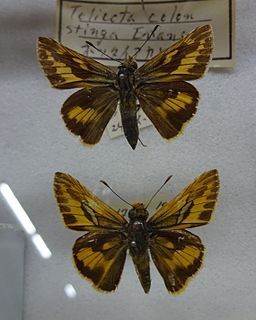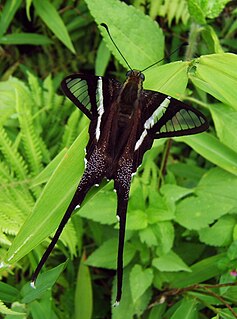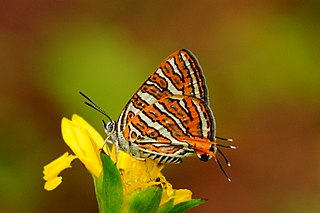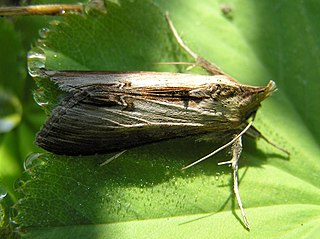
Apamea crenata, known as the clouded-bordered brindle, is a moth in the family Noctuidae. It is distributed throughout the Palearctic realm. In the North it crosses the Arctic Circle, in the Mediterranean it is found only in cool locations and mountains avoiding very hot areas. In the Alps, it rises to an altitude of about 2000 metres.

Telicota colon, commonly known as the pale palm dart or common palm dart, is a butterfly belonging to the family Hesperiidae found in India to Australia.

Lamproptera curius, the white dragontail, is a species of swallowtail butterfly native to parts of South Asia and Southeast Asia where it is common. It belongs to the dragontails genus, Lamproptera, of the swallowtail family, Papilionidae.

Dodona durga, the common Punch, is a small but striking butterfly found in the Indomalayan realm that belongs to the Punches and Judies, that is, the family Riodinidae.

Aporia harrietae, the Bhutan blackvein, is a mid-sized to large butterfly of the family Pieridae, that is, the yellows and whites, which is found in Bhutan and possibly in India.

Miletus symethus, the great brownie, is a small butterfly found in India that belongs to the lycaenids or blues family. The species was first described by Pieter Cramer in 1777.

Cigaritis vulcanus, the common silverline, is a species of lycaenid or blue butterfly found in Asia. It was first described by Johan Christian Fabricius in 1775.

Cucullia asteris, or star-wort, is a moth of the family Noctuidae. The species was first described by Michael Denis and Ignaz Schiffermüller in 1775. It is found through the Palearctic including Japan.

Cucullia chamomillae, the chamomile shark, is a moth of the family Noctuidae. The species was first described by Michael Denis and Ignaz Schiffermüller in 1775. It is found in Central Europe, Southern Europe, the Near East and North Africa.

Grammodes stolida, the geometrician, is a moth of the family Erebidae. The species was first described by Johan Christian Fabricius in 1775. It is found in Africa, southern Europe, most of Asia and Australia. It migrates to central and northern Europe as far north as England, Denmark and Finland.

Nycteola revayana, the oak nycteoline, is a moth of the family Nolidae. The species was first described by Giovanni Antonio Scopoli in 1772. It is found from Europe and east across the Palearctic to Japan and India.
Coamorpha is a genus of moths in the family Megalopygidae. It contains only one species, Coamorpha innoxia, which is found in Costa Rica.
Sufetula polystrialis is a moth in the family Crambidae. It was described by George Hampson in 1912. It is found on the Louisiade Islands.
Habrona marmorata is a moth in the family Drepanidae. It is widely distributed in Papua and Papua New Guinea.
Depressaria artemisiella is a moth in the family Depressariidae. It was described by James Halliday McDunnough in 1927. It is found in North America, where it has been recorded from British Columbia and Utah.
Megalopyge tharops is a moth of the family Megalopygidae. It was described by Caspar Stoll in 1782. It is found in French Guiana and Brazil.
Mesoscia lorna is a moth of the Megalopygidae family. It was described by Schaus in 1905. It is found in French Guiana.
Podalia fuscescens is a moth of the family Megalopygidae. It was described by Francis Walker in 1856. It is found in Brazil.
Podalia lanocrispa is a moth of the family Megalopygidae. It was described by E. Dukinfield Jones in 1912. It is found in Brazil.
Podalia thanatos is a moth of the Megalopygidae family. It was described by William Schaus in 1905. It is found in Costa Rica and Guyana.










